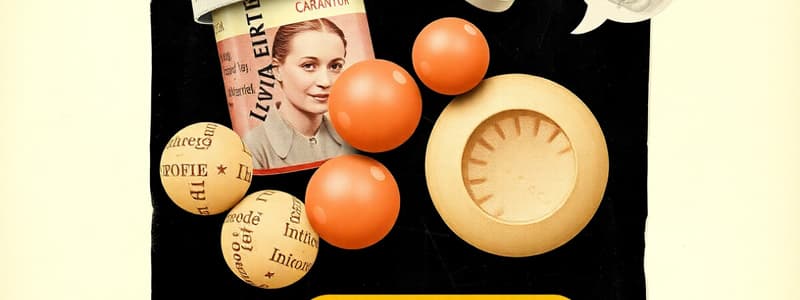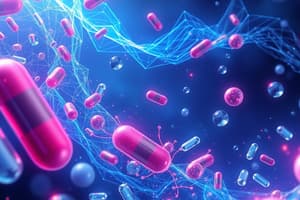Podcast
Questions and Answers
What role does the liver play in lipid metabolism?
What role does the liver play in lipid metabolism?
- Excretion of lipids from the body.
- Synthesis of apolipoproteins only.
- Primary storage of triglycerides.
- Major organ of lipid metabolism and manufacturer of cholesterol. (correct)
What is the composition of a lipoprotein?
What is the composition of a lipoprotein?
- Triglyceride or cholesterol combined with an apolipoprotein. (correct)
- Fatty acids linked to albumin.
- Cholesterol esters bound to globulin.
- Apolipoprotein combined with phospholipids.
Which lipoprotein is responsible for the 'recycling' of cholesterol?
Which lipoprotein is responsible for the 'recycling' of cholesterol?
- High-density lipoprotein (HDL). (correct)
- Very-low-density lipoprotein (VLDL).
- Intermediate-density lipoprotein (IDL).
- Low-density lipoprotein (LDL).
According to the information provided, what level of HDL is considered low?
According to the information provided, what level of HDL is considered low?
What is the general recommendation regarding non-drug means of controlling cholesterol before starting drug therapy?
What is the general recommendation regarding non-drug means of controlling cholesterol before starting drug therapy?
Which of the following is NOT a class of antilipemic drugs?
Which of the following is NOT a class of antilipemic drugs?
When should baseline cholesterol, HDL, LDL, triglycerides, renal and liver function tests be monitored when using HMG-CoA reductase inhibitors?
When should baseline cholesterol, HDL, LDL, triglycerides, renal and liver function tests be monitored when using HMG-CoA reductase inhibitors?
What is a potential side effect of HMG-CoA reductase inhibitors (statins)?
What is a potential side effect of HMG-CoA reductase inhibitors (statins)?
Which of the following substances can delay the metabolism of statins, potentially leading to increased drug levels?
Which of the following substances can delay the metabolism of statins, potentially leading to increased drug levels?
Why are bile acid sequestrants often considered second-line drugs in antilipemic therapy?
Why are bile acid sequestrants often considered second-line drugs in antilipemic therapy?
What is a common side effect associated with Bile Acid Sequestrants?
What is a common side effect associated with Bile Acid Sequestrants?
How does Niacin affect triglyceride and HDL levels?
How does Niacin affect triglyceride and HDL levels?
What is the primary action of fibric acid derivatives (fibrates)?
What is the primary action of fibric acid derivatives (fibrates)?
A patient taking fibric acid derivatives (fibrates) along with a statin should be monitored closely for which potential adverse effect?
A patient taking fibric acid derivatives (fibrates) along with a statin should be monitored closely for which potential adverse effect?
What is the main mechanism of action of ezetimibe (Zetia)?
What is the main mechanism of action of ezetimibe (Zetia)?
Which of the following is a potential adverse effect associated with cholesterol absorption inhibitors?
Which of the following is a potential adverse effect associated with cholesterol absorption inhibitors?
What is the primary use of omega-3 fatty acids as an herbal product?
What is the primary use of omega-3 fatty acids as an herbal product?
A patient who is also taking warfarin should be aware that garlic supplements could cause what?
A patient who is also taking warfarin should be aware that garlic supplements could cause what?
Which herbal product used for hypercholesterolemia may cause diarrhea and allergic reactions?
Which herbal product used for hypercholesterolemia may cause diarrhea and allergic reactions?
What is the MOST important instruction to give a patient who is prescribed cholestyramine powder, to ensure it works correctly and is safe to take?
What is the MOST important instruction to give a patient who is prescribed cholestyramine powder, to ensure it works correctly and is safe to take?
In the context of lipoprotein metabolism, what is the most precise definition of an apolipoprotein's function?
In the context of lipoprotein metabolism, what is the most precise definition of an apolipoprotein's function?
A patient presents with a complex lipid profile: elevated VLDL, normal LDL, and borderline low HDL. If initial non-pharmacological interventions fail, which agent, considering its pleiotropic effects beyond lipid modulation, might be most judiciously selected?
A patient presents with a complex lipid profile: elevated VLDL, normal LDL, and borderline low HDL. If initial non-pharmacological interventions fail, which agent, considering its pleiotropic effects beyond lipid modulation, might be most judiciously selected?
Considering the interplay between hepatic lipid metabolism and systemic atherosclerosis, which of the following best encapsulates the rationale behind aggressive LDL-lowering strategies in secondary prevention?
Considering the interplay between hepatic lipid metabolism and systemic atherosclerosis, which of the following best encapsulates the rationale behind aggressive LDL-lowering strategies in secondary prevention?
In a patient with combined hyperlipidemia and a history of gout, which antilipemic agent should be approached with the greatest caution, and why?
In a patient with combined hyperlipidemia and a history of gout, which antilipemic agent should be approached with the greatest caution, and why?
How do bile acid sequestrants reduce LDL cholesterol?
How do bile acid sequestrants reduce LDL cholesterol?
A patient is prescribed both a statin and a fibric acid derivative. What is the primary concern with this combination?
A patient is prescribed both a statin and a fibric acid derivative. What is the primary concern with this combination?
A patient taking Niacin reports severe flushing and pruritus. What is the most appropriate pharmacological intervention, considering long-term adherence and patient comfort?
A patient taking Niacin reports severe flushing and pruritus. What is the most appropriate pharmacological intervention, considering long-term adherence and patient comfort?
Which statement best captures the consensus recommendation regarding the use of cholesterol absorption inhibitors as monotherapy?
Which statement best captures the consensus recommendation regarding the use of cholesterol absorption inhibitors as monotherapy?
A patient with known cardiovascular disease (CVD) and an elevated LDL-C level is already on a high-intensity statin. Despite adherence, the LDL-C reduction is inadequate. What would be the next most evidence-based step in managing this patient's hyperlipidemia?
A patient with known cardiovascular disease (CVD) and an elevated LDL-C level is already on a high-intensity statin. Despite adherence, the LDL-C reduction is inadequate. What would be the next most evidence-based step in managing this patient's hyperlipidemia?
A patient reports using flaxseed oil to manage their cholesterol. What is the MOST important counseling point regarding potential interactions, considering its mechanism of action and the patient's concurrent medications?
A patient reports using flaxseed oil to manage their cholesterol. What is the MOST important counseling point regarding potential interactions, considering its mechanism of action and the patient's concurrent medications?
Flashcards
Lipids
Lipids
Lipids in the blood that are water-insoluble, requiring apolipoproteins for transport.
Lipoprotein
Lipoprotein
Combination of triglycerides or cholesterol with apolipoprotein, aiding fat transport.
Very-low-density lipoprotein (VLDL)
Very-low-density lipoprotein (VLDL)
Transports endogenous lipids, produced by the liver.
High-density lipoprotein (HDL)
High-density lipoprotein (HDL)
Signup and view all the flashcards
Antilipemic drugs
Antilipemic drugs
Signup and view all the flashcards
HMG-CoA reductase inhibitors
HMG-CoA reductase inhibitors
Signup and view all the flashcards
Action of HMG-CoA reductase inhibitors
Action of HMG-CoA reductase inhibitors
Signup and view all the flashcards
HMG-CoA reductase inhibitors: How long until results are seen?
HMG-CoA reductase inhibitors: How long until results are seen?
Signup and view all the flashcards
Side effects of HMG-CoA reductase inhibitors
Side effects of HMG-CoA reductase inhibitors
Signup and view all the flashcards
Bile acid sequestrants
Bile acid sequestrants
Signup and view all the flashcards
Side effects of bile acid sequestrants
Side effects of bile acid sequestrants
Signup and view all the flashcards
Niacin
Niacin
Signup and view all the flashcards
Side effect of Niacin
Side effect of Niacin
Signup and view all the flashcards
Fibric acid
Fibric acid
Signup and view all the flashcards
Side effects of fibric acid derivatives
Side effects of fibric acid derivatives
Signup and view all the flashcards
Cholesterol absorption inhibitors
Cholesterol absorption inhibitors
Signup and view all the flashcards
Side effects of cholesterol absorption inhibitors
Side effects of cholesterol absorption inhibitors
Signup and view all the flashcards
Omega-3 fatty acids
Omega-3 fatty acids
Signup and view all the flashcards
Considerations when prescribing antilipemics
Considerations when prescribing antilipemics
Signup and view all the flashcards
Aspirin or NSAIDS
Aspirin or NSAIDS
Signup and view all the flashcards
Water-insoluble fats
Water-insoluble fats
Signup and view all the flashcards
Liver's role in lipid metabolism
Liver's role in lipid metabolism
Signup and view all the flashcards
Low HDL level
Low HDL level
Signup and view all the flashcards
High LDL treatment trigger
High LDL treatment trigger
Signup and view all the flashcards
Drugs requiring baseline monitoring
Drugs requiring baseline monitoring
Signup and view all the flashcards
Adverse effects to report
Adverse effects to report
Signup and view all the flashcards
Adverse effect of garlic
Adverse effect of garlic
Signup and view all the flashcards
Study Notes
Triglycerides and Cholesterol
- Lipids are water-insoluble fats in the blood that must bind to apolipoproteins, which are specialized lipid-carrying proteins.
- The liver is the major organ of lipid metabolism and cholesterol manufacture.
- Lipoprotein is a combination of triglyceride or cholesterol with apolipoprotein.
- Very-low-density lipoprotein (VLDL) is produced by the liver and transports endogenous lipids to the cells.
- Low-density lipoprotein (LDL) and high-density lipoprotein (HDL) are types of lipoproteins.
- HDL is responsible for "recycling" cholesterol and is known as "good cholesterol."
Cholesterol and Coronary Heart Disease Risk
- Low HDL levels are less than 40 mg/dL.
- Total cholesterol levels of 300 mg/dL are three to four times greater than in patients with levels less than 200 mg/dL.
- As cholesterol increases, so does the incidence of death from coronary heart disease.
Treatment Guidelines
- Antilipemic drugs are used to lower lipid levels as an adjunct to diet therapy.
- Drug choices should be based on the patient's specific lipid profile.
- Clinical atherosclerotic cardiovascular disease and LDL cholesterol ≥ 190mg/dL are factors in drug choice.
- Diabetics who are 40 to 75 years of age with LDL levels 70 to 189mg/dL and no evidence of CVD should use antilipemic drugs.
- Individuals with no evidence of CVD or diabetes but who have LDL levels, 70 to 189mg/dL and high risk factors for CVD development within 10 years should use antilipemic drugs.
- All reasonable non-drug means of controlling blood cholesterol levels (diet, exercise) should be tried for at least 6 months before drug therapy.
Antilipemics
- HMG-CoA reductase inhibitors (HMGs or statins)
- Bile acid sequestrants
- Niacin (vitamin B3 or nicotinic acid)
- Fibric acid derivatives (fibrates)
- Cholesterol absorption inhibitors (Zetia)
- Herbal medications
HMG-CoA Reductase Inhibitors (Statins)
- Statins are the most potent LDL reducers.
- Examples of statins include pravastatin (Pravachol), simvastatin (Zocor), atorvastatin (Lipitor), fluvastatin (Lescol), rosuvastatin (Crestor), and pitavastatin (Livalo).
- All statins are given orally, and with the evening meal.
- Baseline cholesterol (total, HDL, LDL), triglycerides, and renal and liver function tests should be monitored before and periodically during therapy.
- Results take 6-8 weeks before results are seen.
HMG-CoA Reductase Inhibitors: Action and Effects
- Statins inhibit HMG-CoA reductase, which is used by the liver to produce cholesterol.
- Lowers the rate of cholesterol production, they are a first-line drug therapy for hypercholesterolemia.
- Outcomes include reduced LDL levels, increased HDL levels, and reduced triglycerides.
- Mild, transient GI disturbances, rash, headache, myopathy (muscle pain), elevated liver enzymes, liver disease, and peripheral neuropathy are possible side effects.
HMG-CoA Reductase Inhibitors: Interactions
- Oral anticoagulants should not be taken with statins.
- Statins interact with erythromycin, antifungals, verapamil, diltiazem, HIV protease inhibitors, and amiodarone.
- Grapefruit juice may delay the metabolism of statins.
Bile Acid Sequestrants
- Bile acid sequestrants are considered second-line drugs and may be used with statins
- Examples include cholestyramine (Questran), colestipol hydrochloride (Colestid), and colesevelam (Welchol).
- Colesevelam (Welchol) is taken orally in tablet form with food and 8oz of water, and not with other medications.
- Cholestyramine (Questran) is supplied as a powder.
Bile Acid Sequestrants: Action and Effects
- Bile acid sequestrants prevent the reabsorption of bile acids from the small intestine.
- Bile acids are necessary for the absorption of cholesterol.
- Constipation, heartburn, nausea, belching, and bloating are side effects that get better over time.
Niacin (Nicotinic Acid)
- Niacin is vitamin B3.
- Niacin is effective and inexpensive, often combined with other lipid-lowering drugs.
- Niacin decreases triglycerides and total serum cholesterol.
- Niacin decreases LDL levels and increases HDL levels.
Niacin Action and Effects
- Niacin increases the activity of lipase, which breaks down lipids.
- Niacin reduces metabolism of cholesterol and triglycerides.
- Flushing (caused by histamine release), pruritus, GI distress, hyperglycemia, and hepatotoxicity are possible side effects.
Fibric Acid Derivatives (Fibrates)
- Gemfibrozil (Lopid) and fenofibrate (Tricor) are fibric acid derivatives.
- Outcomes include decreased triglyceride levels and increased HDL levels.
Fibric Acid Derivatives (Fibrates): Actions and Effects
- Fibric acid derivatives activate lipase to break down cholesterol.
- They suppress the release of free fatty acids from adipose tissue.
- They inhibit the synthesis of triglycerides in the liver.
- They increase secretion of cholesterol in the bile.
- Abdominal discomfort, diarrhea, nausea, blurred vision, headache, increased risk of gallstones, prolonged prothrombin time, and myopathy are possible side effects.
Fibric Acid Derivatives: Interactions
- Fibric acid derivatives interact with oral anticoagulants and statins.
- A risk for myositis, myalgias, and rhabdomyolysis increases when fibric acid derivatives are taken with statins.
- Laboratory test reactions include decreased hemoglobin levels, hematocrit value, and white blood cell count, as well as increased activated clotting time, lactate dehydrogenase level, and bilirubin level.
Cholesterol Absorption Inhibitor
- Ezetimibe (Zetia) inhibits cholesterol absorption.
- Cholesterol absorption inhibitors are often combined with statins.
- They are currently recommended only when patients have not responded to other therapies.
- Outcomes include decreased total cholesterol, LDL, and triglyceride levels, as well as increased HDL levels.
Cholesterol Absorption Inhibitor: Action and Effects
- Action is to inhibit absorption of cholesterol secreted in the bile and from food.
- Hepatitis and myopathy are possible effects.
- Contraindicated in patients who have mild to severe liver disorder.
Herbal Products: Omega-3 Fatty Acids
- Omega-3 fatty acids are herbal products used to reduce cholesterol.
- They may cause rash, belching, and allergic reactions.
- There are potential interactions with anticoagulant drugs.
Herbal Product: Garlic
- Garlic is an herbal product used as a lipid reducer.
- Adverse effects include dermatitis, vomiting, diarrhea, flatulence, and antiplatelet activity.
- It has possible interactions with warfarin and diazepam.
- It may enhance bleeding when taken with NSAIDs.
Herbal Product: Flax
- Both the seed and oil of the plant are used, and are used for hypercholesterolemia
- May cause diarrhea and allergic reactions
- Possible interactions: antidiabetic drugs, anticoagulant drugs
Nursing Implications
- Contraindications include biliary obstruction, liver dysfunction, and active liver disease.
- Obtain baseline liver function studies.
- Patients on long-term therapy may need supplemental fat-soluble vitamins (A, D, K).
- Take with meals to decrease GI upset.
- Powder forms must be taken with a liquid, mixed thoroughly but not stirred, and NEVER taken dry.
- Other medications should be taken 1 hour before or 4 to 6 hours after meals.
- To minimize adverse effects of niacin, start on a low initial dose and gradually increase it, and take with meals.
- Small doses of aspirin or NSAIDs may be taken 30 minutes before niacin to minimize cutaneous flushing.
- Inform patients that these drugs may take several weeks to show effectiveness.
- Instruct patients to report persistent GI upset, constipation, abnormal or unusual bleeding, and yellow discoloration of the skin.
- Monitor for adverse effects, including increased liver enzyme studies.
- Monitor for therapeutic effects to show reduced cholesterol and triglyceride levels
SDOH (Social Determinants of Health)
- 30 Tablets of Zocor without insurance will cost $195.65
- 30 Tablets, 40mg each of the generic lipitor costs ~$126.99 without insurance
- Questran - 1 Box, 60 packet each of the generic cholestyramine costs $148.99
- The out-of-pocket cost of a lipid panel can range from $200 to $843 without insurance and $19 with private insurance or Medicare
Studying That Suits You
Use AI to generate personalized quizzes and flashcards to suit your learning preferences.




